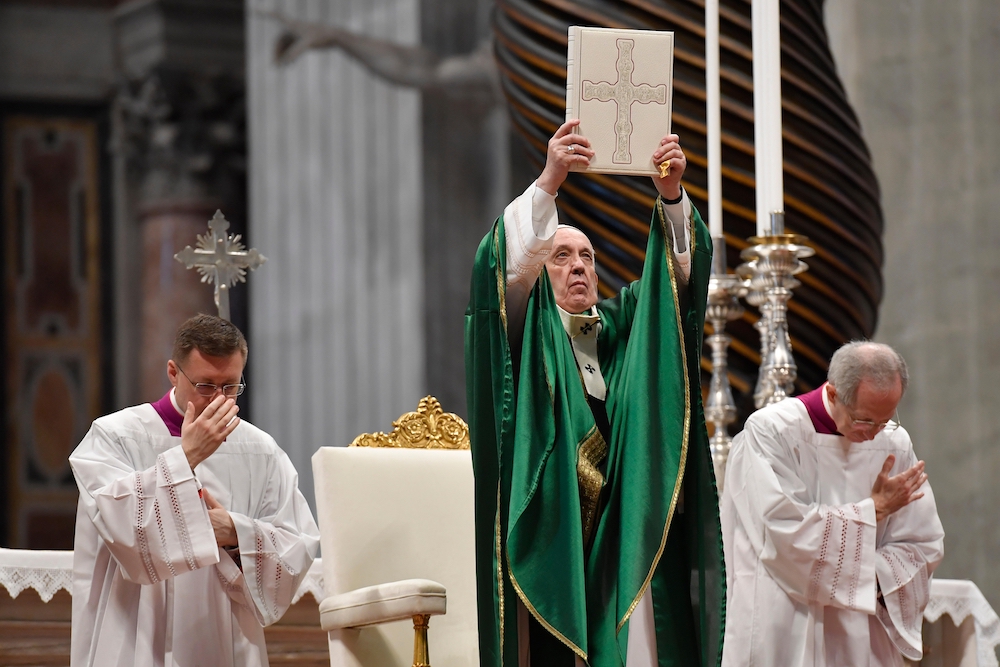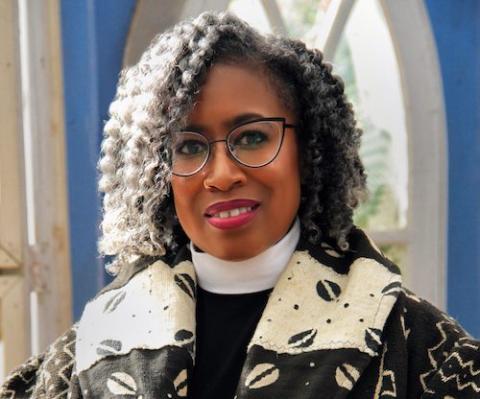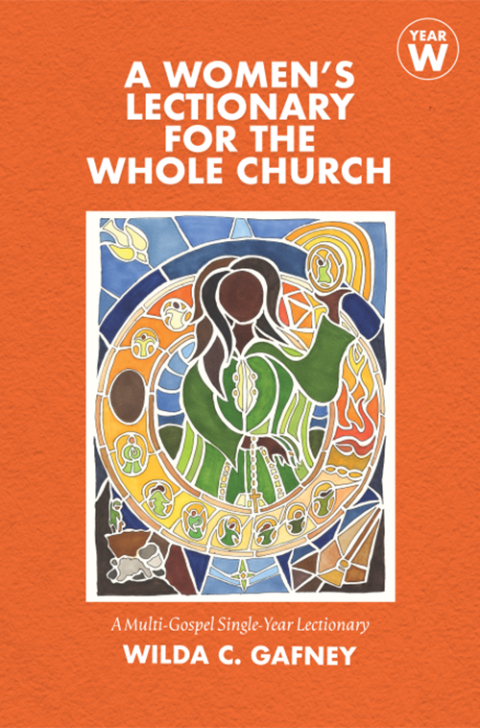
Pope Francis holds up the Lectionary (or book of Mass readings) that was used during the Second Vatican Council, Jan. 26, 2020, in St. Peter's Basilica, the first Sunday of the Word of God, encouraging Catholics to read the Bible, as Vatican II desired. Christine Schenk calls the Rev. Wil Gafney's "A Women's Lectionary for the Whole Church" a "combination of impeccable scholarship and pastoral usability." (CNS/Vatican Media)
Reviewing the Rev. Wil Gafney's new A Women's Lectionary for the Whole Church (Church Publishing) has filled me with gratitude and delight. This long-awaited resource is a rare combination of impeccable scholarship and pastoral usability. A Hebrew and rabbinic scholar and professor of Hebrew Bible at Brite Divinity School, Gafney also happens to be an Episcopal priest who preaches regularly. In the introduction to the new Lectionary she asks,
What does it look like to tell the Good News through the stories of women who are often on the margins of scripture and often set up to represent bad news? How would a lectionary centering women's stories, chosen with womanist and feminist commitments in mind, frame the presentation of the scriptures for proclamation and teaching?
Her questions led to two years of intensive labor developing Year A and Year W of the new Lectionary with Years B and C still to come. Year W is a composite single year lectionary for denominations that do not use a three-year cycle of lectionary readings.

The Rev. Wil Gafney, Episcopal priest and professor of Hebrew Bible at Brite Divinity School, Fort Worth, Texas (Courtesy of Wil Gafney)
Why is a women's lectionary needed? Gafney counts the ways. Citing statistics from the Pew Research Center she notes that of the nearly 2.3 billion Christians in the world, about 1.4 billion engage Scripture from denominations that regularly use lectionary texts. An estimated 60% of U.S. Christians attend churches that regularly use lectionaries.
Because of the androcentric nature of biblical texts there are only an estimated 205 named female characters compared to an estimated 1,181 named men. But androcentrism is more than numbers. In a recent Women Erased presentation for FutureChurch, Gafney pointed out that because of male authorship, "Even when a woman is present, her story is serving a male story. If it's focused on her, the larger arc is still a male story." Given these realities — and the fact that the lectionary is a catechetical (teaching) text — it is unsurprising that in her introduction Gafney writes "not many of my students or parishioners can name even 10 women in the biblical canon."
Since lectionary committees — guided in part by the Scriptures themselves — have selected predominantly male-oriented texts, people rarely learn about biblical women on Sunday — or any other time for that matter.
For Gafney, "Androcentrism, sexism, and misogyny in the scriptures, in their translation, and in their preaching and liturgical use, hurts men and boys and nonbinary children and adults as much as it does women and girls." Exclusively male God language reinforces the idea that men image God and women do not. Most women and girls have never experienced their gender as being associated with the divine. Yet for those who have had that experience, writes Gafney, "it has been profoundly moving, rare, and even sometimes profoundly disturbing."
Centering the stories of biblical women and girls — whether named or unnamed — in a lectionary requires no small amount of scientific creativity. Text selection was second only to translation as Gafney's most time-consuming task. To this end, she prioritized passages in which women and girls were explicitly present while also selecting texts in which they were present but "obscured in plurals and other groupings, e.g., 'children,' 'Israelites,' 'people,' 'believers,' etc."
To establish a "female canon within the broader canons of scripture," Gafney used Accordance Bible Software to identify passages containing "explicit language for female persons." She also designed a second search to capture singular and plural constructions for feminine terms such as mother, daughter, sister, wife, mistress, etc. While the results were "not necessarily exhaustive" she found them "more than sufficient for the task."

Cover to the Rev. Wil Gafney's A Women's Lectionary for the Whole Church
A consummate Hebrew linguist, Gafney translated all of her own texts. She is well acquainted with Hebrew words and grammatical constructions connoting the female gender. To construct the new lectionary she matched themes from each of the liturgical seasons with texts from her newly created female canon. She then searched for "readings that shared thematic language or specific words that related to the liturgical season and first lesson" ("reading" in the Catholic context). Search results were saved according to location — Hebrew Bible (including the seven deuterocanonical books)*, Psalms, New Testament — which facilitated the selection of appropriate texts for each week's readings and psalms. She also used specific passages from the Psalms, Gospel or Epistles that came to mind.
Gafney's lectionary translations are accompanied by "text notes" that identify the original language and translation choices and "preaching prompts" that suggest ways to connect the biblical text to the experiences of contemporary believers.
The new lectionary always uses a female pronoun for the Holy Spirit. In her text notes for Pentecost, Gafney writes that in the Hebrew Bible, the Spirit of God (ruah) is grammatically feminine, a fact that has been obscured because "translators have historically avoided grammatical constructions that would require a pronoun for the Spirit in the First [Old] Testament." In the Septuagint (the first Greek translation of the Old Testament) and the Christian Scriptures, the Greek word for "spirit" is neuter (pneuma).
The upshot, writes Gafney, is that "In the breadth of the scriptures the spirit is anything and everything but masculine." This changed when Jerome translated the Bible into Latin.
Gafney politely continues:
The deliberate choice to render the spirit in masculine terms in Latin texts such as the Vulgate reflects theological commitments apart from the grammar of the texts. If we were to hear Jesus speak John 14:17 in Aramaic, we would most likely hear: This is the Spirit of truth, whom the world cannot receive because it neither sees her nor knows her. You know her, because she abides with you, and she will be in you.
To help women and girls "encounter God in explicitly feminine language," Gafney used mainly feminine pronouns for God in the Psalms as well as occasional nonbinary pronouns. Here is an example:
… you who seek God let your hearts flourish.
For the FAITHFUL GOD hears the needy,
And those who belong to her and are imprisoned,
She does not despise.
Let the heavens and earth praise her.
The seas and everything that moves in them. (Psalm 69:32-34)
Following the practice of respected earlier translators, Gafney uses descriptive titles for God rather than the artificially constructed "LORD" (with large and small caps) used in mainstream translations to denote the untranslatable holy name, YHWH. She eschews this "common male human slave holding title," choosing instead to "preserve the ancient biblical and rabbinical practice of substituting something that can be said for that which cannot."
Thus, diverse, biblically rooted titles for God recur throughout the Lectionary. Here is a small sampling: ONE WHO IS, SOVEREIGN, WISDOM, HOLY ONE OF OLD, CREATOR, GOD WHO HEARS, SHE WHO IS HOLY, WOMB OF CREATION and YOU WHO ARE.
Advertisement
Gender-expansive translations are another Gafney innovation in which named collections of people in the scriptures—"Israelites," "children," "people" — are expanded to include their gendered subgroups. For example, "Israelites" is translated to "the women, children, and men of Israel." She also commonly includes the matriarchs in genealogies, for example Abraham [and Sarah], Isaac [and Rebecca], Jacob [and Rachel]. Gafney's selections and translations avoid anti-Semitism using "Judeans" rather than the pejorative "the Jews" and she carefully modulates "dark/black" negative language to become "shadow" and "bleak/ness." Slave/slavery language is maintained, "rather than weaken or minimize" this horrific historical reality with the word "servant."
In developing her project, Gafney involved 63 "conversation partners" from 14 English-speaking denominations around the world. None were Catholic. This is sad but unsurprising given the Catholic hierarchy's well-publicized ban on female liturgical leadership. She also sought feedback from Protestant clergy, seminarians and lay leaders with a range of gender identities. This widespread consultation aided text and translation choices as well as Gafney's many practical suggestions. The latter are specifically designed to help ordinary congregations engage the Scriptures in new and personal ways even as they become more biblically literate.
Some practical suggestions for Protestant denominations include using the full lectionary for a three-year cycle or replacing a year in the three-year cycle currently in use. Practical suggestions for both Catholic and Protestant groups include using the lectionary for Bible study, as a resource in the theological classroom, and for personal prayer and devotional reading. All are encouraged to access the list of biblically rooted divine names for God to enrich theological language in liturgy and corporate or personal prayer.
Gafney's paradigm-shifting scholarship will influence biblical preaching and teaching for generations to come.
Gafney dedicated her new lectionary "For those who have searched for themselves in the scriptures and did not find themselves in the masculine pronouns."
As one who often cannot find herself in the masculine pronouns of today's liturgical offerings, I am profoundly grateful for this beautiful, scholarly rendition of texts I have loved since childhood even if I didn't always see myself in them.
As I — and many women and men like me — mature in contemporary consciousness, too many lectionary selections no longer adequately convey God's dynamic, eternally relevant Word. Instead they risk becoming a painful countersign to the Holy One in whose image all of us are made. I have written elsewhere about possible solutions to these pressing concerns within the Catholic context.
Of one thing I feel quite certain: Gafney's paradigm-shifting scholarship will influence biblical preaching and teaching for generations to come.
It is time for Catholic liturgical leaders to follow her lead.
*This column has been updated to specify that the seven deuterocanonical books were included in the Hebrew Bible, and to properly format small and large caps for God names.








